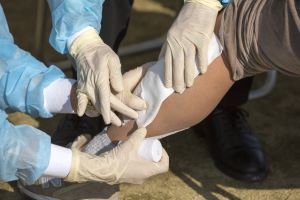
Private disaster relief organizations have become key leaders in community resilience when disaster strikes. Their support is critical in providing immediate aid for disaster response, and to supporting community recovery by contributing necessary redevelopment resources.
Natural and made-made disasters have not only become more frequent and intense over the past 15 years, but they have also become much more costly. In fact, 2022 records from the National Centers for Environmental Information report that the U.S. alone has undergone 338 climate and weather disasters since 1980, where the cost of damages, response, and recovery services for individual disasters reached or exceeded $1 billion. To put it into perspective, the total costs of all these events combined adds up to over $2.295 trillion.
This upward trend for both the number of disasters and the increased cost of disasters is only expected to continue as climate change strengthens its grip on the environment. While climate change exacerbates the frequency and severity of the disasters themselves, the nation is also adding millions of units to its housing stock. This gives any potential disasters like wildfires, hurricanes, floods, and tornadoes more property to damage, which in turn displaces more people who need humanitarian aid services, shelters, and disaster assistance.
While preparing an emergency management plan to mitigate these disasters is the federal government’s best first course of action in protecting vulnerable communities, the unfortunate fact is that major and long term factors such as climate change and the overdeveloped housing market are out of the government’s hands when it comes to emergency response.
In addition to these uncontrollable circumstances, community based response and recovery efforts have a tendency to be difficult to execute as well as complicated and slow to get up and running efficiently. This is especially true of local and state governments that do not receive enough funding and grants, especially from the Department of Housing and Urban Development, to have adequate access to the resources they need to appropriately respond to hazards and disaster survivors.
From an emergency healthcare staffing standpoint, the amount of medical providers who have relevant training and expertise to work efficiently on a disaster relief team does not nearly match up with the volume of providers that are realistically needed to help in recovery efforts from disasters at the scale at which they have been, and will continue to, devastate communities.
In combination with little and/or last minute funding, especially from the Department of Housing and Urban Development (HUD), can often result in a sole reliance on those healthcare professionals on response teams who are adequately trained, which can lead to higher levels of burnout and staff turnover.
That’s where private disaster relief and emergency response locum tenens staffing agencies like Wellhart come in. Government institutions are increasingly turning to private disaster relief organizations because they are constantly preparing for an emergency event and building up their resources long before disaster strikes. Accordingly, when their services are needed, they are already prepared to immediately respond with ample and suitable assets to fulfill the full breadth of government contract needs within their industry.
Working with Wellhart, for example, takes the burden off of the federal government to find the proper amount of trained and experienced medical and mental health professionals who are ready for immediate deployment because we continuously communicate with, and build upon our extensive provider network. Once our healthcare professionals are deployed, they work to provide the most quality care to the best of their abilities, and provide a calm, safe, and reassuring presence to disaster survivors.
When private disaster relief organizations take on government contracts, they are also able to use their niche industry knowledge to work with their allotted budget more efficiently. This means that the contractor will work to allocate the correct amounts of funds to the most appropriate places in order to best fulfill their contract.
The reason that private disaster relief agencies are so committed to fulfilling their contracts to the best of their ability is because one of the largest goals of these organizations is to win as many government projects as they can. This means that private disaster relief agencies want to build positive portfolios of their past work to show government institutions that they have a history of success. Thus, these organizations work particularly hard on every project to fulfill needs to the absolute best of their abilities.
Wellhart’s strong relationships with our vast database helps us to make certain that the right providers get on the ground to fill the right amount of open positions for any need, no matter how big, small, or urgent.
Ready to get started with your new disaster relief partner? Get in contact with us to speak with an experienced representative today!
